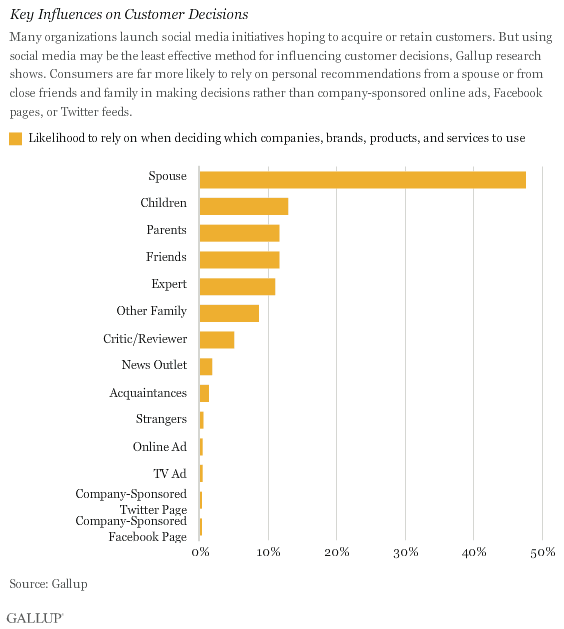Today, Facebook has more than half a billion active users; Twitter users send more than 140 million tweets per day; and other social media outlets boast millions more logging in every day. That's an enormous marketing forum, and organizations of all types have invested a fortune into using social media to acquire customers. But does that approach actually work?
Not in the way you might think. Recently, Gallup conducted research with more than 17,000 social media users -- evaluating everything from the latest mobile social media apps to old-school word-of-mouth. We discovered groundbreaking new insights into how people interact with social media and into its effectiveness as a marketing tool.
These findings debunk three big myths regarding social media: that it effectively drives customer acquisition, that social networkers are all the same, and that social networking is an online-only phenomenon. But more important to companies spending tons of money on social media initiatives, Gallup's research also suggests practical actions that can make these efforts more effective.
Myth: Social media initiatives drive customer loyalty and acquisition.
Fact: Engagement with a brand drives social engagement.
This first myth cuts to the core of what organizations want social media initiatives to accomplish: getting new customers and keeping existing customers. Yet according to Gallup research, brand-sponsored social media initiatives have very little impact on consumer decision making. Nor do they drive prospective customers to consider trying a brand or recommending a brand to others in their social network. (See graphic "Key Influences on Customer Decisions.")

Brand-sponsored social media initiatives don't have much influence on a customer's deep rational and emotional attachment, which we call customer engagement. Gallup analysis shows that it works the other way around: Customer engagement with a brand drives social engagement, the degree to which customers will work for or against your company or brand within their social networks.
And customer engagement can't be won solely with an app. Gallup research has found that customer engagement is the result of the fulfillment of four psychological needs and three rational needs. For a company to benefit from social engagement, it usually must create customer engagement first. (See graphic "The Customer Engagement Hierarchy.")

The more emotionally attached customers are to your organization, the more likely they are to resolve tension between their positive and negative beliefs -- what psychologists call cognitive dissonance -- about your organization in your favor. That's because as your most engaged customers use your product, service, or brand, it becomes part of their own identity -- something psychologists call symbolic self-completion. When this happens, criticizing that product is tantamount to criticizing themselves.
The most frequent type of social networking is still analog -- face-to-face or over the phone.
That's why you need to go beyond measurements of rational satisfaction or recommendation-based metrics like Net Promoter to understand the rational and emotional factors that bond customers to your brand. Building on this understanding, our analysis revealed these key points about customer behavior:
- Customers are more predisposed to be positive about your organization and more willing to work on your behalf with their social networks than are prospects, who are less engaged with your organization.
-
Customers are more likely to give you a pass when they have something negative to say, particularly if they are highly engaged. About three-fourths (74%) of fully engaged customers had positive social engagement (engaging their social networks in a complimentary way) and no negative social engagement (engaging in a derogatory way) about a brand, product, or service. In contrast, only 1% of actively disengaged customers had positive social engagement with a brand, product, or service, while 14% had negative social engagement.
-
Prospective customers are much more likely to try your product or service or advocate on your behalf if they hear good things about you from an engaged customer in their social network. Prospects are most likely to rely on people they have close relationships with or trust, such as a spouse or family member or an expert. They are much less likely to trust online or TV advertising or corporate-sponsored Facebook pages or Twitter feeds. (See graphic "Key Influences on Customer Decisions.")
If your organization is considering whom to target with its social media initiatives, keep these key points in mind:
-
You're less likely to engage prospects directly through social media. Encourage or guide your current customers to advocate on your behalf instead.
-
Focus your efforts on your most engaged customers because they are the most likely to advocate on your behalf and the least likely to criticize you.
Myth: Social networking is an online-only phenomenon.
Fact: Social networking predominantly happens offline.
Ten years ago, customer advocacy circles talked about creating "buzz," finding your "hubs" or "worker bees," and relying on "herd instinct" to distribute favorable word-of-mouth for your organization. Then, just as marketers were trying to dollarize these efforts, shiny, fast, and trackable digital social networking platforms emerged and appeared to provide the solution. Yet we're still talking about the same thing: how to dollarize word-of-mouth efforts within social networks, albeit through digital social media channels.
It's important to note the difference between what we mean by social networking and social media. Social networking is the act of engaging a social network; social media comprises the channels through which people network. This leads us to some bad news for the digerati: Digital-only social media initiatives are leaving far too many prospects and customers untapped. Our analysis suggests that the most frequent type of social networking is still analog -- face-to-face or over the phone. This holds true among all types of social networkers, even younger social networkers (which we'll cover in part 2 of this article).
When organizations plan their social networking initiatives, too many of them mistake the media for the message. They seek to drive specific business outcomes by managing infinitesimal online response metrics like followership, app downloads, hashtags, or click-throughs rather than creating content or ideas that resonate with their prospects or customers and fostering engagement regardless of the method or channel.
What then is the key to effective social networking? Don't confuse the channel for the desired outcome. Social engagement can and must be measured and managed across all channels -- online and offline.
Myth: All social networkers are the same.
Fact: People use social networks in very different ways -- and for very different reasons.
Marketers have customer segmentation down to a science. Today, they can target and approach prospects based on small clusters of highly focused similarities. Some organizations even talk about full customization -- segmenting and targeting down to the individual consumer.
Yet this same methodology isn't typically used in the social media space. Instead -- bowing to the argument that "everyone is doing it, so we should too" -- many organizations approach social media as a tactic in search of a strategy.
But using mass tactics to reach consumers implies that all social networkers are the same. They're not. Gallup research shows that social networkers have different intrinsic reasons why and how they use their networks. They won't change those to fit your organization, so the key is to understand these differences and align your initiatives to them.
In part two of this article, James and Asplund will address how social networkers are different and provide practical actions companies can take to drive social engagement.
Survey Methods
Results are based on a Gallup Panel study consisting of web surveys completed by 17,254 national adults, aged 18 and older. Respondents were deemed proficient internet users based on their ability to complete the survey via the web. The study was conducted in September and October 2010. Gallup Panel members are recruited through random selection methods. The panel is weighted so that it is demographically representative of the U.S. adult population. For results based on this sample, one can say with 95% confidence that the maximum margin of sampling error is ±1.43 percentage points. Margins of sampling errors vary for individual subsamples. In addition to sampling error, question wording and practical difficulties in conducting surveys can introduce error or bias into the findings of public opinion polls.
